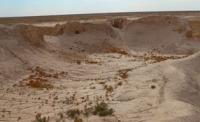Вы здесь
Ashag-asar ancient settlement.

Excursions to ancient settlements of Jety-asar.
"Winners and losers learn different lessons from history"
Drive from Kyzylorda to Jety-asar.
The Ashag-asar settlement is located in the Karmakchinsky district of the Kyzylorda region, 4.3 kilometers north of the "Small House" fortress of the Altyn-asar complex. The fortress walls of the settlements were preserved only in the form of low wide ramparts, the towers nowhere protrude beyond the line of the walls.
The preservation of the walls does not allow us to talk about the types of alleged loopholes. The material from the settlements themselves makes one think about their belonging to a different ethnic, foreign cultural population and about the comparative short duration of the existence of these settlements themselves.
The Ashag-Asar settlement has irregular rectangular outlines in plan, an area of 60 x 50 meters, with a preserved height of an average of 1.5 meters above the level of the modern surface. Fortress walls (with a total thickness of 9.5 meters) with a defensive corridor, 2.4-2.8 meters wide, are traced along the perimeter of the settlement.
The walls are made of rectangular bricks, standard 38-42 x 24-30 cm, with five towers that do not protrude beyond the line of the walls. The entrance to the settlement was in the middle of the eastern wall. In lifting ceramic material from this settlement, which makes it possible to attribute the period of its existence to the last centuries BC. - the first centuries A.D., vessels characteristic of the first stage of the Middle Syr Darya cultures prevail (Levina, 1971, p. 90).
When erecting the Dzhetyasar buildings, blocks of broken clay-pakhsa of an unsteady standard and large-format raw bricks were used, in the overwhelming majority of cases - rectangular in plan.
Authority:
L.M. Levina. “Ethnocultural history of the Eastern Aral Sea region. 1st millennium BC -1 millennium AD ". 1996 year. Publishing house "Eastern Literature".
Photos by
Alexander Petrov.







